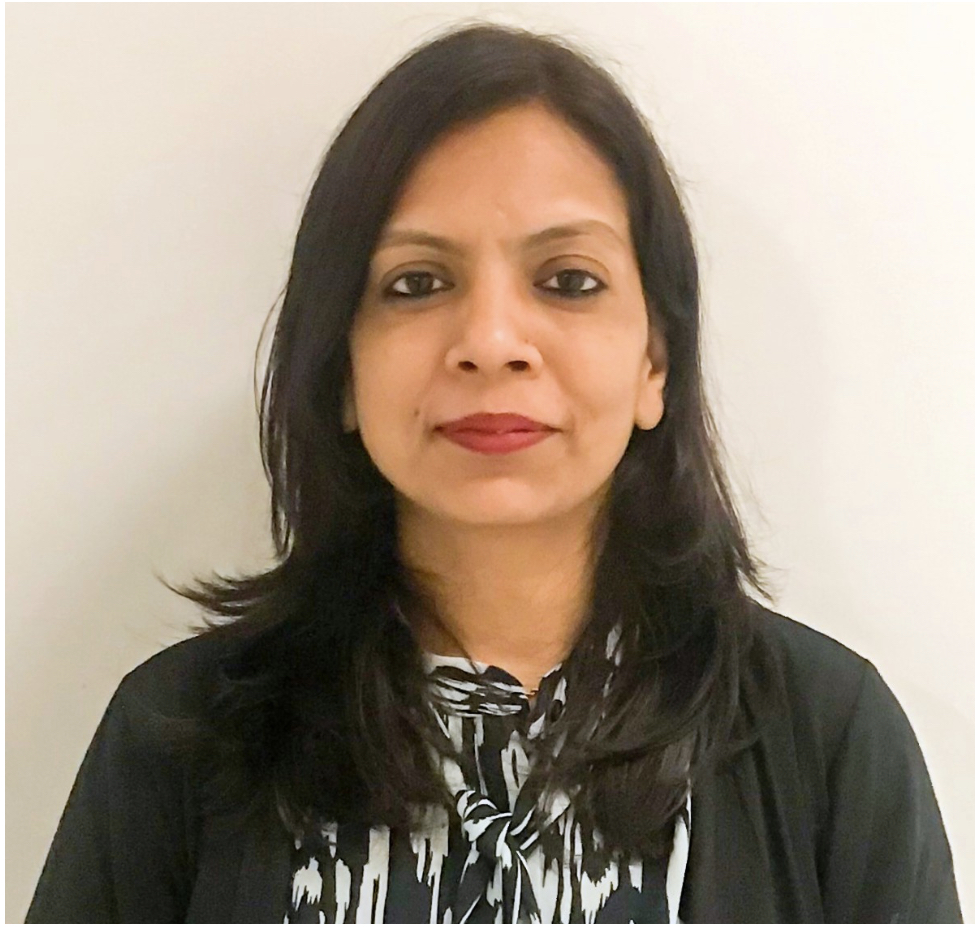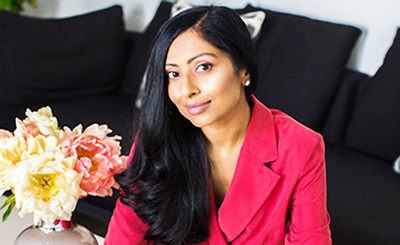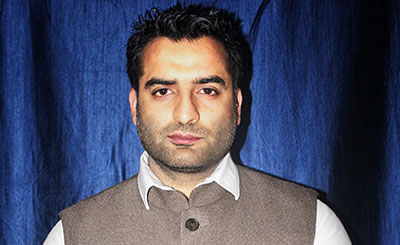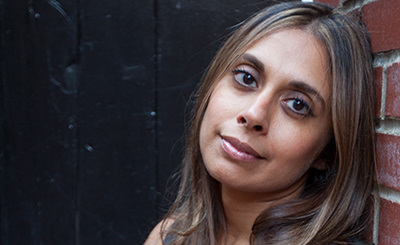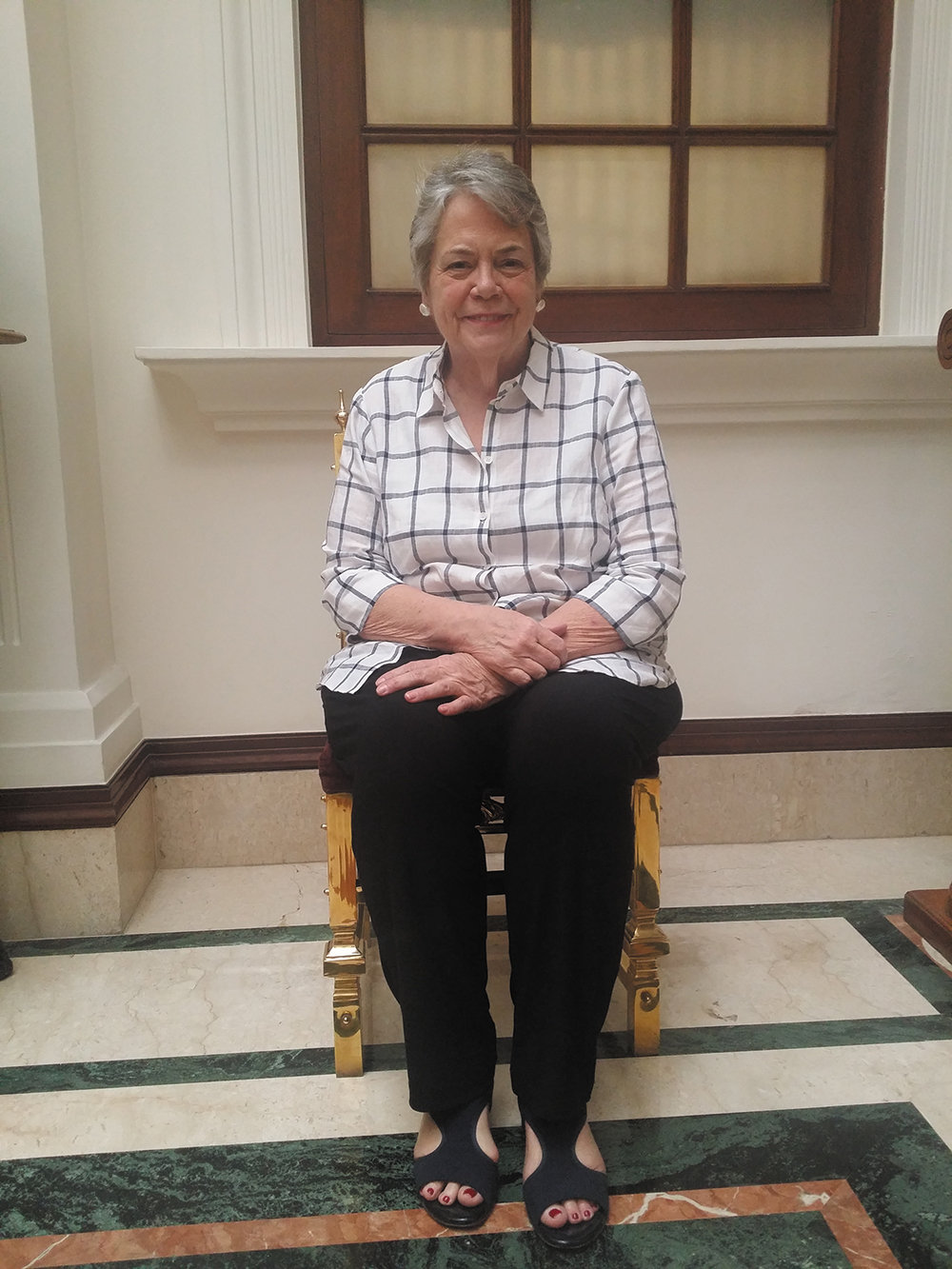
Carolyn Reidy, president and CEO, Simon & Schuster Inc. Photos: Shireen Quadri
Carolyn Kroll Reidy has been president and Chief Executive Officer at Simon & Schuster Inc. since January 2008. Reidy first joined Simon & Schuster in 1992 as president and publisher of the then trade division. She joined Simon & Schuster from Avon Books, where she had been president and publisher since 1988. Reidy began her publishing career at Random House in 1976 and moved to William Morrow as subsidiary rights director in 1983. She returned to Random House in 1986 as publisher of Vintage Books and associate publisher of the Random House imprint. She serves on the Boards of Directors of the Association of American Publishers, the National Book Foundation and Literacy Partners Inc.
Having graduated from Middlebury College in 1971, with a B.A. degree in English and Russian, Reidy did her M.A. in 1974 and Ph.D. in 1982 in English from Indiana University.
At Simon & Schuster, Reidy is responsible for the publishing and business activities of all divisions of Simon & Schuster, including Simon & Schuster Adult Publishing Group, Simon & Schuster Children’s Publishing, Simon & Schuster Audio, Simon & Schuster Digital, and international companies in Canada, the UK and Australia. Reidy has served as president of Adult Publishing Group of Simon & Schuster Inc since 2001. She oversees all of Simon & Schuster’s domestic and international publishing operations.
Reidy was named one of “The 50 Women to Watch” by the Wall Street Journal in 2007. She has also been cited as “100 Most Powerful People in Entertainment” by Entertainment Weekly.
Reidy was in India recently to flag off the Simon & Schuster India’s local publishing programme. Speaking to The Punch, she said she was not worried about publishing. “I feel that whether it’s digital, physical or something we don’t even know yet — audio, etc — these are just formats and new ways of delivery. We’re still delivering the same thing,” she said.
Excerpts from an interview:
SHIREEN QUADRI: Tell us something about Simon & Schuster India operations. And the decision to launch the local publishing programme now, five years after the Simon & Schuster started its India chapter.
CAROLYN REIDY: We established five years ago in India and the first thing we wanted to do was make sure we had our sales and marketing organisations properly situated, getting the right people with right energy level. Rahul Shrivastava, (Managing Director), along with his team, has been doing a terrific and effective job with the titles that were provided from England and the United States. They have done a great job, establishing their place and identity in the market.
About a year ago, we said to Rahul, “It’s time. You’ve done a great job so far. Let’s begin to build our local publishing list.” It took him some time to identify and hire Dharini Bhaskar (Editorial Director) to lead the editorial effort of the publishing list. And she has certainly hit the ground running. Rahul and Dharini have already acquired eight titles for the inaugural list for 2017 and some for the lists that follow after that. They have been very careful in trying to make sure that for a list that we envision, being smallish while starting out, the goal is one book a month — in effect 12 books a year, so that every book on that list can get the attention and effort. My expectation is that we will probably go on to at least double that. We’re not looking to compete with very large English-language publishers in India who do 100 or 200 books a year. That’s not our vision. Our vision is to keep it small and focused — a combination of fiction and non-fiction, literary and commercial. When you publish a list that’s small, naturally, you give more time to every book. In addition, we hope that Dharini would find some books that’d be of interest to us because Simon & Schuster is very strong in the United States, Canada, England and Australia. The idea is that at least some of the books from the local publishing list in India will also travel to our other national publishing arms and we can then provide some Indian authors worldwide-strength in publication. That’s definitely part of the vision from Day One and what’s exciting is that some of the titles that have already been announced, some other publishers around the world are already interested in reading the books and seeing whether they can add them to their list. So far, the vision has been the same as it was when we began.
SHIREEN QUADRI: Publishing in India, even though it remains a very fragmented and unorganised sector, has tremendous potential. In addition to the growing English-language speakers, there are new generations of readers who are now better exposed to the language, partly due to technology. For Simon & Schuster India, is there any shift in strategy compared to its operations elsewhere?
CAROLYN REIDY: India is a fairly unique publishing industry, precisely because for its population, it’s relatively small. Therefore, the growth potential is huge. We definitely see that. It’s fascinating to me that although the number of smartphones is growing in the country, ebooks have not taken off. Clearly, the Indian market prefers not to read books, digitally at least. I’ve always thought that digital did a great service to the book industry because when you read on your phone or your computer, it’s actually putting even greater value on reading. In India, as the population has increased, we see in the young the desire to read and to be able to read and enjoy books. In the United States, too, it’s true, though the younger generation has gone to digital less enthusiastically than the older ones, because they do so much on their phone they don’t need to read books there.
The potential in India is so huge for the growth of the market and the real question is where and how will that growth come. Clearly, the literacy rate is very high and getting higher every year. So, partially, it’s a matter of instilling the value of reading books, both to get ahead but also just for pleasure and entertainment and enjoyment. There is a task that the publishing industry needs to do: To encourage reading as the thing that people want to do in their leisure time, whatever time they have. So the potential in India is really large. We are going to rely on our team here to tell us what we should do. We make available to them all the stuff we publish in the rest of the world. It’s fascinating for them to choose these books, telling us the books that will work in India as well as those that will be of less interest. They have done a great job in localising what we publish in the rest of the world. We do see each national publishing programme as sui generis, each one really expands the market it is in and the idea was now we have things that can cross over. I’d say that in America, England, Australia and Canada, each one of our publishing programmes is creating their own kind of strategy and vision and have things going forward. One thing I’d say that has changed in the rest of the world is that we thought that digital would take over a larger and larger per cent, but ebooks seem to have been declining now for two years. In India, they never took off, but everywhere else they did. And now they have gone from being about 30 per cent of overall business to about 20 per cent. It seems to be leveling off between 15-20 per cent.
SHIREEN QUADRI: What do you think is the reason for this decline?
CAROLYN REIDY: I think there are several things. They (those who read on devices) have got screen fatigue, almost. They have so much they have to do on their phones — they use mobile as a phone, but also for email, messaging and games and whatever, that it’s like they want to take a break from them. We do know that children’s books, for instance, never sold well as ebooks because parents… it’s like if my child already spends too much time on screen, I’d want him to experience something else. Secondly, they have actually done research in America and found that when you read digitally, you don’t remember as well as you do when you read a physical book. If you think about yourself, when you go back to a passage, you remember the right hand side or the lower left hand side, but digitally you can’t do that. So, there is a kind of tactile memory that you get from reading a physical book. It seems to also help comprehension. And that digital reading was not a fad but it was new, it was exciting and it’s still great when you travel because you don’t have to carry 10 books with you. So, there is a lot of benefit to it. A lot of information you can get that you don’t necessarily need a book for any more. So, reference publishing has some challenges, needless to say. But for reading long-form fiction and non-fiction, it’s questionable whether it’s in fact better. And I think the public is saying, “No it’s not.” That the book, the €400 book, still has a value that has not been replaced by anything that has come since then.
The other thing that’s growing big everywhere but it’s not in India yet is the digital audio. Audio books, which used to be sold on disks, were expensive. A Stephen King novel, for instance, which ran into 15 disks, cost $50. But the digital version now costs only $15. Digital audio has been growing by 30-40 per cent a year in America. Now, it’s trying to go to England. And no one is yet offering here in India. And partially that’s because of business and taxation questions that are not clear. So, it’d be very difficult for anybody to actually just start offering it. But once they give result that, clearly, will be a sign that consumers have now really got into consuming books while listening to them.
SHIREEN QUADRI: For those who have gone digital, the idea is to give readers less (a short story or a novella) since it suits the format. Things may not seem to have picked up in India when it comes to e-publishing, but does it look promising? Is the way we read set to be revolutionised?
CAROLYN REIDY: It remains to be seen if consumers actually want this. They may, by the way. I’ve worked with the idea of subscription where you get to read a little bit every day. I myself have signed up for some of those in America and then I find I don’t read them because it’s like an appointment. So then I compared it to say the Netflix model where people want the whole thing. They don’t actually want to watch TV now every week on Monday night at 7 o’ clock. They want to wait till it’s over and then they want to watch the whole thing at their time. So, what remains to be seen in terms of literature or reading, whether the consumers would want to be fed in little bits or whether they would rather decide on their own how much they read in any one time. So, it’s a worthy experiment. In fact, there have been examples. A long time ago in Japan, they used to do commercial fiction on cellphones everyday and it was very popular. I remember looking at it at that time. In America, there are people trying it even now as we speak. But, so far, it has not actually caught on anywhere. That leads me back to this: people want two things, they want in little bits — so they want songs and not the album — or they want bits of the story and the whole thing as they want to be able to totally control themselves. This goes back to the good old-fashioned book, in which you turn the pages and put a marker when you’re done. So, it’s all whether they want the option of both remains to be seen. So, the interesting thing to me about digital is, I do believe very firmly that there would be a new form of the book somehow. But I also don’t think we even can imagine it. So, what we have done so far is try, and we have all tried it, to take the book and done what we think makes it new — put movies in it or put pictures in the middle or throughout it or let you go from the book to some other site that explains something to you or chapters in pieces — we have done all these different things. But they are not really new. It’s really taking the old things and just packaging it differently. But some young person is, in fact, going to come up with something completely different that I’m probably too old to even think of. And hopefully we will all recognise it. That will be the thing that will truly revolutionise the book for the future.
I just have to believe that given the power of the entire digital and internet platform, there has got to be something that some brilliant young person has figured out and that will interest us all too. There is plenty of great stuff being done, most of it you try. We have tried and enhanced ebooks, we have done all kinds of stuff, but the public doesn’t really want them because when you read, you’re in the book, you’re in the words, you don’t actually want to be thrown out of the book and do something else, which is really what we first all experimented with.
SHIREEN QUADRI: For many of us, the value of a physical book or a physical bookstore remains the same. Amazon itself, for instance, is now opening physical bookstores. This marks a reverse transition. Talking about Amazon, there are a lot of questions surrounding publishing. Many publishers here would say that the profit margin, when you sell on Amazon, is very low. How do you see Amazon changing the dynamics worldwide? How does Simon & Schuster work with Amazon?
CAROLYN REIDY: First of all, we all have to give Amazon credit. They have done a fabulous job. They made every book available to everyone, which, therefore, has increased sales and books that’d never have still been in a bookstore today, they come and go in bookstore because they only have so much real estate, but they are all available. And they have made books available all around the world. So, you can publish a book in India and it’s available in America even without an American publisher. So, the job they have done — making books available everywhere — is phenomenal. Secondly, they have done it under a model that says everything should be done for the consumer. So, they have cut their margins to make it very, very thin. That also has increased the number of books in people’s hands all around the world. And, also, if you’re in India and if you publish in a local language, that book can be available too. Imagine the Indian who lives in Florida, who can now buy a book in his native language: he could never have done that before. So, what they have done is phenomenal. On the other hand, of course, they have become very powerful and so they can be challenging for a publisher to deal with. When there was all this discussion in the United States, one of the things we did was try to think very clearly as to what did Amazon really want? It wasn’t that they just wanted the discount. They had principles for what they wanted. And we came up with an offer back to them that matched what their guiding principles were and also made sense for us. So, we ended up with a deal with them that made us very happy going forward. It is very much a challenge, however, particularly for a bookshop because they are paying real estate and they are paying more clerks and people and all that. What happened in America that’s fascinating is that the bookstores, in response to this, have said, “Ok, we have to make ourselves viable for another reason, not price.” And they have made themselves into community outlets. They have made themselves a place people want to go to. From everything we can tell people rarely go online to discover anything. They go online when they already know what they want. So, we have done publicity on a book or we have got reviews on a book or somehow we got the public to know to say they may go to Amazon and just click and buy. But they don’t go there to find and discover it. They still got to the bookstores to discover. Bookstores took that idea and they have a lot of signings in their stores, they have events in their stores, they make them the place for book clubs to meet, they support their local community — they very much want the local shop movement in America and say this money stays in the community, you should support us — and they got their own clientele to be stronger and more devoted to them. One of the other things they did is that they ended together to create a new online platform called Digital Selling. It’s not really much of a competition to Amazon, but at least they can make it available to their customers.
So, whereas in the past, there was a kind of store that said ok, we are going to give you selection and price — for Amazon really took selection and price off the table — so then you have to say, well, what am I offering that’s not those two things? Should I offer a loyalty programme that gives them some discount, still not going to be the Amazon discount, but give them something? Should I have a reason why someone would want to come in the store every week or every two week — they are really focused on that. They created their own bestsellers’ lists, their own recommendation lists, they became sort of closer to their own clientele, and they have actually been growing in sales over the last three years.
Now, a lot of stores ran out of business, the ones that couldn’t respond to that, they ran out of business, but publishers also support the stores because the showrooming effect, the place for books to be discovered. We encourage the people who run the stores to read and get more copies; we want them to talk about the books because they are the ones who actually help the sales of the book. Bookstores had the publishers realise the value of their part and so it’s possible that price is not the only thing… you can find an audience that will support you for all these other reasons. Now, there are fewer bookstores than there were before, but for the last three years, the American Booksellers Association has actually grown in number of stores.
Page
Donate Now
More from The Byword
Comments
*Comments will be moderated



